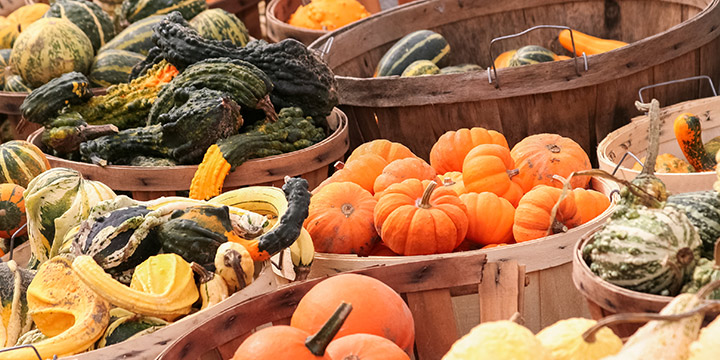Acorn, butternut, spaghetti, and delicata are just some of the varieties of winter squash in season now. They come in a variety of shapes, colors, and sizes and offer important nutrients. Winter squash have a tough skin which helps them keep fresh for a while but it can make them difficult to cut or peel. Fortunately, there is a way to make the process easier:
- Rinse the skin of the squash under cool running water.
- Pierce the skin in several places with the prongs of a fork.
- Microwave the squash for two to three minutes.
- Let the skin cool slightly before peeling or slicing.
How you prepare the squash will depend on the type of squash you have and the recipe you’re using. Here are some simple ways to prepare two popular varieties, butternut and spaghetti. Make sure you save the seeds and try our Roasted Squash Seed recipe. They’re great for a snack by themselves, on top of salad, or mixed with dried fruit.
Roasted Butternut Squash: This type of winter squash is an excellent source of vitamin A, one cup is almost 300% of the recommended dietary allowance for one day! Vitamin A is important for the body’s immune system functions. It also plays a key role in maintaining eyesight and cell growth and regeneration. Roasting the squash brings out its sweet flavor and is an easy to prepare side dish for lunch or dinner. Use leftovers in soups or on top of salad, or mash them up for the Baked Squash Too recipe.
Spaghetti Squash: With its cylindrical shape and yellow hued skin, spaghetti squash is an often overlooked member of the winter squash family. While it doesn’t taste like spaghetti, it does separate into long strands when cooked and you can definitely twirl it around your fork like you would with its more traditional namesake. It is much more delicate than pasta but has a similar texture, kind of like angel hair. The flavor is very mild and doesn’t bring the sweet, bold and earthy “squash” flavors to the table. Because if this mildness, you can top it with various sauces or ragu (or anything else you usually top noodles with) and it won’t compete with the flavors.
Written by Lauren Casale RD, LDN


